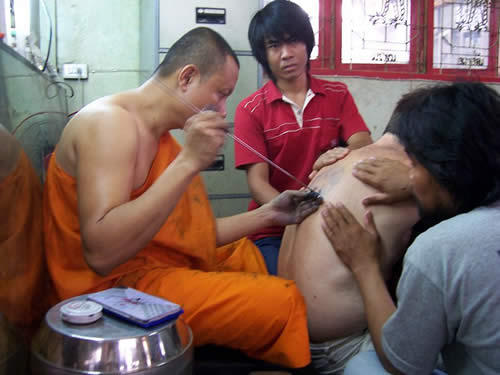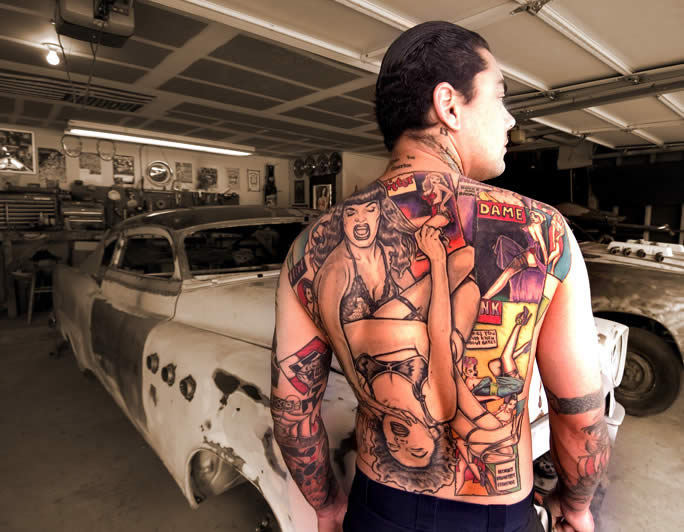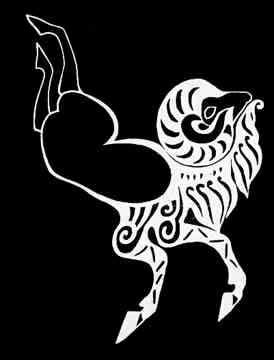
|
|
| Celeb Tattoos | Facts & Stats | Designs & Symbols | History | Culture | Links | Tattoo Galleries | Contact | |
|
What Makes a Good Tattoo? Article © 2009 PJ Reece "There is never a guarantee of a good tattoo," advises Brazilian tattooist, Mauricio Teodoro. This honest but sobering news from one of the world's top tattoo artists is meant to warn the tattoo virgin that, despite the tattooist's best intentions, he or she is only human. Tattooists work on days when they may not feel their best, and they may work on people about whom they don't have the most positive feelings. Then, there's the tattoo itself. "If the design has a connotation that the artist can't agree with, he should definitely not perform the tattoo." If Teodoro sounds hyper-selective, he is. He works on a single client each day so he can focus his attention in a way most other tattooists cannot. "Artists who work in fast-paced studios," he says, "or who are under financial pressure, have to perform many tattoos in a day, bringing the quality of their work down." On a technical level, a successful tattoo has 'personality', according to Teodoro, which comes from analyzing the human body. "Good tattoos are tattoos that follow the body lines and move with it. It has to move with the person, the body and the tattoo lines all in harmony. This is essential." Mauricio Teodoro was interviewed for this article by Adriana Maria Zimbarg, who has written extensively about body modification, and who has much to teach us about the elusive 'good tattoo', starting with her own personal tattoo journey: "I got my first tattoo when I was a pre-teen," says Zimbarg, "and it did suffer quite a bit with stretch due to my growth and the thousands of times that I put it through the monstrous process of leg waxing. It is still here, not as pompous as it was once, but every time I look at it, I know that this old phoenix helped me to become who I am." Zimbarg confesses to being very picky about who she consults when planning a tattoo. She recently went searching for an artist to meet the challenge of her particularly intricate and meaningful design. Her story (and refreshingly honest style) serves as perhaps our most valuable guide to acquiring that 'good' tattoo.
Zimbarg's online article goes far beyond assessing the tattooist's demeanor, skill and credentials, to valuable considerations in advance of breaching the door of the tattoo studio, and about subsequent care of the tattoo. Here are a few highlights:
Zimbarg reminds us (tip #13) that the best tattoo artist isn't one who simply does a proper job, but one who feels 'obliged' by his profession to do a good job. To a pro like Mauricio Teodoro, that involves being sure the client knows what they're asking for. "The person has to understand the meaning of the tattoo he wants," says Teodoro, who confesses that his best tattoos result from working on people with whom he feels a mutual respect. "If I feel that the person is unsure about any aspect of the tattoo, I'll advise them to look for another artist who might better suit their needs." Over at Skin&Ink, editor Bob Baxter concurs. "Tattoos are very, very personal," he says, "and so is the connection between giver and receiver. The mystical, magical experience of getting tattooed - the ambiance, the small talk, the smell of green soap - all that contributes to the bonding between tattooist and customer." Thailand's famous Buddhist tattoo monks have turned this client-artist relationship into a spiritual event. Over the years, Thai men have received intricate tattoos as an homage to religious or spiritual powers, especially those motifs that might bring positive change to their lives. The obligation for an effective tattoo falls to the monk-tattooist, who must apply all his concentration to the job at hand - literally - these are hand-tapped tattoos. (Machine tattoos won't impart the necessary 'power' to protect or bless the wearer.) The tattoo master must focus entirely on the outcomes sought for this tattoo, whatever the client desires. To purge his heart of his own agenda, the monk chants Buddhist sutras as he works. Performed with enough devotion and skill, it is believed that the client's tattoo will be empowered to answer his prayers.
Tattoo as prayer. Good. Very good. Of course, skill alone should guarantee a technically good tattoo, but our enquiry seems to be drifting more to the metaphysics of tattoo. To avoid a lengthy digression on the nuts and bolts of tattoo artistry itself, you could check out DG Wilson's article, "To Create an Artistic Tattoo". Wilson's detailed instructions lend us an idea of what tattoo expertise is all about. Here, for instance, is what he has to say about 'design':
Hopefully, your tattooist isn't surfing the Internet to learn the trade. Where and by whom was your artist trained? And how long was the training? According to American tattoo advocate, Karen L. Hudson, you want to avoid a tattooist who believes that the business is a get-rich-quick scheme. On her blog (www.tattoo.about.com) Hudson writes:
Hudson extols the virtues of the apprenticeship route to tattoo proficiency in her online article "What Makes a Good Tattoo Artist". "Learning how to effectively apply a tattoo to hundreds of different kinds of skin without damaging your client can take months or even years," writes Hudson.
While it's unlikely that prospective tattooists in the West would commit five years to an apprenticeship, it's worth knowing that the Japanese tradition - now in danger of vanishing - called for precisely that. You could almost guarantee receiving a good tattoo if it came from the hands of a master horishi, who had first of all been taught humility. According to Kazuo Oguri, the first two years were spent in the master's house doing nothing but menial chores . Eventually, the student was allowed to draw, then make the tattoo needles, and eventually practice on his own body. And all the time, the apprentice was learning the meanings of the traditional tattoo designs. In his article, "Traditional Japanese Tattooing", Oguri remembers his master telling him, "You shouldn't be satisfied with your work as a tattoo artist ever. Until you die, you must continue to train, and make efforts to improve your skills." Kazuo Oguri leaves us with advice that we can apply directly to our list of criteria for the elusive 'good' tattoo:
Oguri would probably support the current passion for strong, monochrome tribal tattoos. I find it especially encouraging, since the animal motif that has me under its spell is just such a bold graphic. It's a sheep, a ram, but one that appears to be in an altered state. It was found on a mummy exhumed from a frozen burial mound in 1948. Take a look - it's so unquestionably beautiful that it's hard not imagine it being 'a joy forever'.
'Pazyryks', they were called, iron-age horsemen who ruled the Siberian Plain 2500 years ago, and who obviously knew a thing or two about art, and for whom their fantastical tattoos are said to have served spiritual, even ritualistic purposes. The romance of it is disturbing. I've researched the inherent symbolism, starting with the hind legs that are upward-turned, aiming for the heavens. I learn that in the art traditions of many cultures, the dead are represented as 'inverted', symbolizing the reversal of life. And the spiral motif, obvious in the ram's horns and leg joints, suggests the infinite. According to mythologist Joseph Campbell, the mythical pilgrimage to God is woven into our psyches, a spiral journey getting ever closer to the center, a process of continual growth and death and rebirth repeated and repeated, never ending. I like that. There's nothing more powerfully vague than metaphysics. People spend lifetimes contemplating the unknowable. Though close to being convinced that this is my tattoo, I'm still not sure I wouldn't be better off commissioning an artist to render the beast with acrylic on canvas and then hanging it above my fireplace. And, then, one final consideration -- while surfing the web I found my Pazyryk Ram for sale on T-shirts and mugs. What next, a cartoon character on the Disney Channel? Adriana Maria Zimbarg is a much better advocate than I am for the good tattoo, so we'll end on her experience navigating a course through the minefield of dangers that lie between the urge and installation of that perfect tattoo. We've seen how much effort went into choosing her tattooist, yet all that was preceded by years of perfecting her artwork - finding it, then adapting and changing it until she got it exactly right. "The tree is a willow," she explains. "Among the Wiccans, the willow is pure and has the healing power. It was a landing place for an old phoenix, so it could rest and be borne again. The tree is on fire, so it represents the idea of a reborn phoenix. "Starting from the 'reborn point' down my tail bone, the line of phoenixes divides my life into past, present and future. Also, it shows my evolution as a person. I decided to free the last phoenix, the one on the back of my neck, which is why it is the most beautiful and the strongest one of them all. That's what I hope will happen to me when I get very old. The two large phoenixes on the sides are what I call 'guardians'. They're there to protect this evolution process, keeping it safe." Zimbarg's tattoo process is inspiring - the intelligence with which she's approached her tattoo, and the space she gives it to grow old with her. Yet we're hearing from some heavily-tattooed icons of the body-art world that too much is made of 'meaning'. Clearly, they don't need any rationale for acquiring another tattoo, just the discovery of a few square inches of blank skin is enough. Their cynicism is understandable, but it does nothing to turn the tide of people flooding into tattoo removal clinics. It does nothing to help the sincere tattoo virgin chose a design they won't eventually regret. What the tattoo world needs now is more people speaking up to help avoid the bad tattoo. "It broke my heart," says Bob Baxter of Skin&Ink magazine, when I saw a photo of a lovely young woman who had gone to a so-called professional tattooist, who, in a phrase, screwed this poor girl royally. She was pretty and blond, with a three-quarter-inch black ribbon tattooed around her neck. Not only was the ribbon crooked, but it looked like it was painted on and the masking tape slipped. Jagged edge, smears, runs, you name it. So, you say, the girl must have known it was a botched job. Really? She sent in the picture to be published in the magazine, didn't she?" Beauty, it would seem, lies in the eye of the beholder. Which is too bad. Hopefully, this article has made a case for training those eyes on some of tattoo's more pragmatic aspects. Perhaps a tattoo's performance - good, bad, or ugly - depends upon how sincerely we've researched our symbols and plumbed the depths of our psyche to discover its special needs. It's possible that, today, we need tattoos more than ever, and if so, then the adventure of finding one that works for us will demand that we know ourselves better. Which can't be a bad thing. And we might even find ourselves with a tattoo that really is 'a joy forever'. |
|
|
|
|
| Celeb Tattoos | Facts & Stats | Designs & Symbols | History | Culture | Links | Tattoo Galleries | Contact | |


